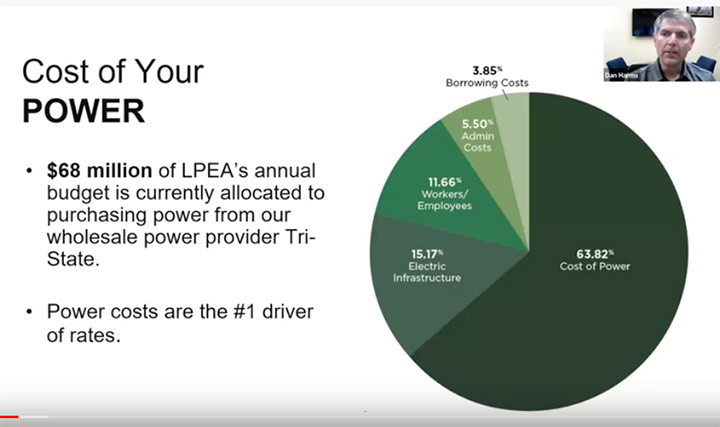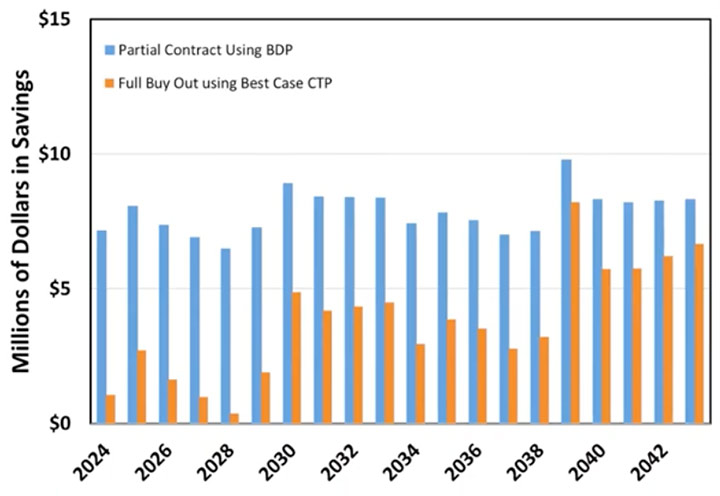La Plata Electric Association, the consumer cooperative that provides electricity to La Plata and Archuleta Counties, held another ‘town hall’ meeting last week via Zoom, to update co-op members on the latest developments. The attendees were welcomed by LPEA Board president John Witchel.
“And I want to take an extra moment to thank all of the staff, not just for taking the time to participate in the Town Hall, but also for the two-plus years of hard work that have led to this moment in time. We are super grateful for everything you guys have done for this community, and are incredibly proud to be at this — I don’t think it would be an overstatement to say — historic juncture in the history of Durango.”
With that said, Daily Post readers are welcome to peruse the following one-hour video, posted by LPEA on YouTube… (and which, incidentally, also applies to Pagosa Springs and Archuleta County.)
LPEA has spent at least the past two years exploring alternative sources of electricity.
“Affordable, reliable, low-carbon electricity”, in the words of Board president Witchel.
The electricity we’ve all been using, these past few decades, has sometimes been less affordable than what customers in other Colorado communities have been paying (while being more affordable than in other communities.) In my personal experience, our electricity itself — as delivered to our communities by the massive electricity co-op known as Tri-State Generation and Transmission — has been reliable, although we’ve had the usual occasional problems with local power lines and transformers and substations that you might expect, living in a four-season climate in the middle of nowhere.
The electricity has not, however, been especially ‘low-carbon’. According to a 2016 document from Tri-State, about 73% of the electricity it provides to its members derives from generating facilites burning fossil fuels. (That percentage could change in the near future, if Lake Powell and other declining reservoirs in the American West lose their ability to generate ‘renewable’ hydroelectricity, the primary source of Tri-State’s ‘renewable-style’ electrons.)
The February 10 Town Hall was the third in a series of LPEA town hall meetings, and was the final event before the LPEA Board of Directors votes on the options presented. The vote takes place tomorrow, Wednesday, February 16.
One of the key goals set by the LPEA Board is to cut the coop’s carbon footprint by 50% between now and 2030, while keeping the cost of electricity “lower than 70%” of LPEA’s electric co-operative peers.
One of the major factors in the cost to members is, of course, the price charged to LPEA when purchasing electricity from Tri-State. Other factors include the cost of employees, the decisions to upgrade older equipment, efforts to mitigate potential wildfire threats, and the ability to get customers to use electricity during times when overall demand is lower.
Among other factors.

Recent contract negotiations with Tri-State resulted in permission to increase purchases from a local solar installation, and a 4% reduction of the wholesale price of Tri-State electricity.
Other negotiations with Tri-State have resulted in an agreement to allow LPEA to purchase 50% of the co-op’s electricity from providers other than Tri-State. One such future provider — Crossover Energy Partners — has been identified and negotiations are currently in progress. The ‘50%’ agreement has not yet been provided to FERC (Federal Energy Regulatory Commission) for its presumed rubber stamp.
A third prong in our co-op’s long-range negotiations involves disassociating completely from Tri-State. The cost of getting out of a signed 50-year contract with Tri-State is currently awaiting a decision by FERC. In the video from the February 10 town hall, Vice President Dan Harms stated that “we’ve got a little bit of insight” into what price FERC might determine is a fair price for a complete exit from the LPEA-Tri-State contract.
“Now I do want to point out that we are not abandoning any one of these three prongs. We’re just picking one that we feel is the right path to take forward and focus on today, but we’re absolutely not eliminating any one of these three, going forward.”
We can assume, when Mr. Harms uses the word, “we”, he actually means “the 12 members of the LPEA Board of Directors“, three of whom represent Archuleta County.
Here’s a graph shared by Mr. Harms, showing the projected savings (in money) from a ‘50% buyout’ from Tri-State and an assumed 50% contract with Crossover — shown in blue — compared with the savings that might come from a ‘full buyout’ — shown in orange.

The ‘50% buyout’ solution would also immediately reduce LPEA’s carbon footprint by 50% sought by the LPEA Board, assuming that the other electricity supplier would be Crossover Energy Partners — a relatively new company that is not saddled with the legacy fossil-fuel generating plants that Tri-State will presumably be decommissioning over the next couple of decades.
Looks like this might be a no-brainer for the LPEA Board.
While I was writing this editorial, I noticed that my office ceiling lights were still on, even though plenty of sunshine was streaming through the window. I thoughtfully turned off the lights, thus saving several watts of electricity which then became available to other people in my community.
But I left my computer running.
